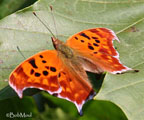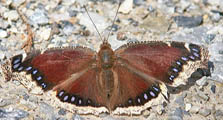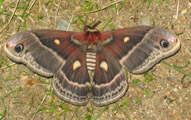Native Plants
Search for native plants by scientific name, common name or family. If you are not sure what you are looking for, try the Combination Search or our Recommended Species lists.
Ulmus rubra
Ulmus rubra Muhl.
Slippery Elm, Red Elm, Gray Elm, Soft Elm
Ulmaceae (Elm Family)
Synonym(s): Ulmus fulva
USDA Symbol: ulru
USDA Native Status: L48 (N), CAN (N)
A 40-60 ft., sometimes taller, tree with a somewhat vase-shaped outline. Branchlets are less pendulous than U. americana. Dark green, rough leaves with fuzzy undersides. Tree with broad, open, flat-topped crown of spreading branches and large rough leaves.
The thick, slightly fragrant, edible, gluelike inner bark is dried and afterwards moistened for use as a cough medicine or as a poultice. This "slippery" inner bark (found by chewing through the outer bark of a twig) is helpful in identification. The Latin species name refers to the large brown buds covered with rust-colored hairs.
From the Image Gallery
Plant Characteristics
Duration: PerennialHabit: Tree
Leaf Retention: Deciduous
Leaf Arrangement: Alternate
Leaf Complexity: Simple
Leaf Shape: Obovate , Ovate
Leaf Venation: Pinnate
Leaf Margin: Double-serrate , Serrate
Leaf Apex: Acuminate
Leaf Base: Oblique
Fruit Type: Samara
Size Notes: Up to about 110 feet tall.
Leaf: Green
Autumn Foliage: yes
Fruit: Green
Bloom Information
Bloom Color: Red , Yellow , Green , BrownBloom Time: Jan , Dec
Distribution
USA: AL , AR , CT , DC , DE , FL , GA , IA , IL , IN , KS , KY , LA , MA , MD , ME , MI , MN , MO , MS , NC , ND , NE , NH , NJ , NY , OH , OK , PA , RI , SC , SD , TN , TX , VA , VT , WI , WVCanada: ON , QC
Native Distribution: S.w. ME through extreme s. Que. & Ont., to s.e. ND, s. to n.w. FL, GA & c. TX
Native Habitat: Rich bottomlands; stream banks; idle ground
Growing Conditions
Water Use: HighLight Requirement: Sun , Part Shade
Soil Moisture: Moist
Soil pH: Alkaline (pH>7.2)
CaCO3 Tolerance: High
Drought Tolerance: High
Soil Description: Moist, rich to dry, limestone soils.
Conditions Comments: Susceptible to Dutch elm disease. Considered weedy as it tends to infest hedges, fence rows and other idle gournd.
Benefit
Use Medicinal: The moist inner bark is the source of the well-known slippery elm ingredient used in throat lozenges.Attracts: Birds , Butterflies
Larval Host: Mourning Cloak, Columbia silkmoth
Butterflies and Moths of North America (BAMONA)
|
Question Mark (Polygonia interrogationis)  Adult Food Source |
Mourning Cloak (Nymphalis antiopa)  Larval Host |
Columbia silkmoth (Hyalophora columbia)  Larval Host |
Find Seed or Plants
View propagation protocol from Native Plants Network.
National Wetland Indicator Status
| Region: | AGCP | AK | AW | CB | EMP | GP | HI | MW | NCNE | WMVE |
| Status: | FAC | FAC | FAC | FACU | FAC | FAC | FAC |
From the National Organizations Directory
According to the species list provided by Affiliate Organizations, this plant is on display at the following locations:Pineywoods Native Plant Center - Nacogdoches, TX
Bibliography
Bibref 1186 - Field Guide to Moths of Eastern North America (2005) Covell, C.V., Jr.Bibref 298 - Field Guide to Texas Trees (1999) Simpson, B.J.
Bibref 1185 - Field Guide to Western Butterflies (Peterson Field Guides) (1999) Opler, P.A. and A.B. Wright
Search More Titles in Bibliography
Web Reference
Webref 3 - Flora of North America (2014) Missouri Botanical Garden, St. Louis, MO & Harvard University Herbaria, Cambridge, MA.Additional resources
USDA: Find Ulmus rubra in USDA PlantsFNA: Find Ulmus rubra in the Flora of North America (if available)
Google: Search Google for Ulmus rubra
Metadata
Record Modified: 2022-09-26Research By: TWC Staff